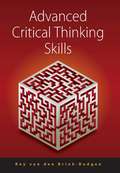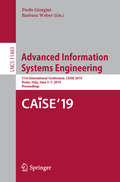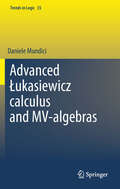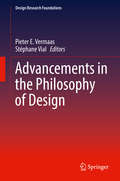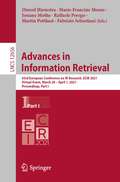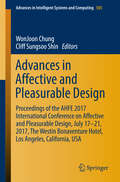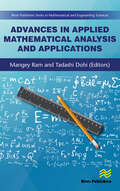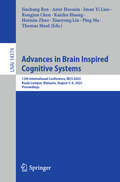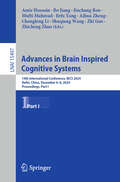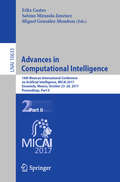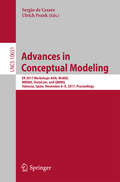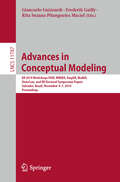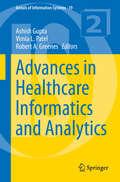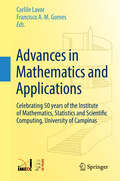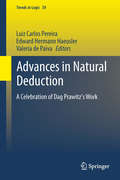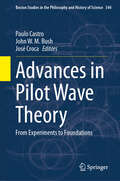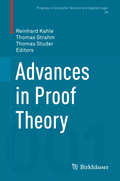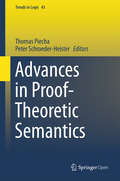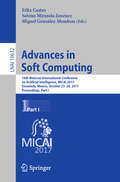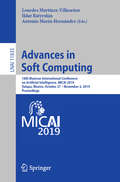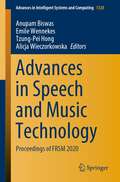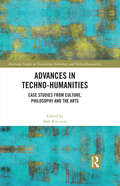- Table View
- List View
Advanced Critical Thinking Skills
by Roy Van Den Brink-BudgenThis book takes the skills introduced in Roy van den Brink-Budgen's bestselling book Critical Thinking for Students and extends and builds on them. As a result, it will be especially useful for students on advanced level courses, whether in schools, colleges, or universities. It shows how complex arguments can be built up, analysed, and evaluated. It also shows how the use of various types of claim can be approached in argument, by stressing the need to ask a series of questions about their possible significance. The frequent role of explanation in the drawing of inference is also detailed. In addition, it applies Critical Thinking skills to decision-making, showing how these skills can clarify the choices available, their possible consequences, and the criteria needed to make decisions. In short, this book shows how to become an even more active and effective Critical Thinker.
Advanced Information Systems Engineering: 31st International Conference, CAiSE 2019, Rome, Italy, June 3–7, 2019, Proceedings (Lecture Notes in Computer Science #11483)
by Barbara Weber Paolo GiorginiThis book constitutes the refereed proceedings of the 31st International Conference on Advanced Information Systems Engineering, CAiSE 2019, held in Rome, Italy, in June 2019. The 41 full papers presented in this volume were carefully reviewed and selected from 206 submissions. The book also contains one invited talk in full paper length. The papers were organized in topical sections named: information system engineering; requirements and modeling; data modeling and analysis; business process modeling and engineering; information system security; and learning and mining in information systems. Abstracts on the CAiSE 2019 tutorials can be found in the back matter of the volume.
Advanced Łukasiewicz calculus and MV-algebras (Trends in Logic #35)
by D. MundiciThis is a continuation of Vol. 7 of Trends in Logic. It wil cover the wealth of recent developments of Lukasiewicz Logic and their algebras (Chang MV-algebras), with particular reference to (de Finetti) coherent evaluation of continuously valued events, (Renyi) conditionals for such events, related algorithms.
Advancements in the Philosophy of Design (Design Research Foundations Series)
by Pieter E. Vermaas Stéphane VialThis volume presents 25 essays on the philosophy of design. With contributions originating from philosophy and design research, and from product design to architecture, it gives a rich spectrum of state of the art research and brings together studies on philosophical topics in which design plays a key role and design research to which philosophy contributes. Coverage zooms in on specific and more well-known design disciplines but also includes less-studied disciplines, such as graphic design, interior architecture and exhibition design. <P><P>In addition, contributors take up traditional philosophical issues, such as epistemology, politics, phenomenology and philosophy of science. Some essays cover philosophical issues that emerge in design, for instance what design can do in addressing societal problems, while other essays analyze main-stream philosophical issues in which design is part of the argument, as for instance abduction and aesthetics. Readers will discover new research with insightful analyses of design research, design thinking and the specificity of design. Overall, this comprehensive overview of an emerging topic in philosophy will be of great interest to researchers and students.
Advances (Univocal)
by Jacques DerridaOriginally published in 1995, Advances was first written by Jacques Derrida as a long foreword to a book by one of his most promising former students, the philosopher Serge Margel&’s Le Tombeau du Dieu Artisan (The Tomb of the Craftsman). What Derrida uncovers for us is Margel&’s own unique theory of the promise in relation to an an-archic, pre-chronological temporality, in conjunction with Margel&’s radical rereading of Plato&’s Timaeus. As Derrida states right away, Margel&’s reading is a new one, a new reading of the Demiurge. A new promise. A new advance. In this magisterial late essay by Derrida, what the reader soon discovers is in part a conversation with his former student, as well as an opening for a new reflection on our current ecological and political crises that are all the more urgent today where the possibility of giving ourselves death as a human race and the end of the world is now, within an era of climate change, more real than ever.As part of Univocal&’s Pharmakon series, this essay, itself published in advance, becomes a brief but powerful light pointing toward Univocal&’s forthcoming publication of the translation of Serge Margel&’s Le Tombeau du Dieu Artisan. &“Once again the Timaeus, of course, but a different Timaeus, a new Demiurge, I promise.&”
Advances in Information Retrieval: 43rd European Conference on IR Research, ECIR 2021, Virtual Event, March 28 – April 1, 2021, Proceedings, Part I (Lecture Notes in Computer Science #12656)
by Marie-Francine Moens Josiane Mothe Djoerd Hiemstra Raffaele Perego Martin Potthast Fabrizio SebastianiThis two-volume set LNCS 12656 and 12657 constitutes the refereed proceedings of the 43rd European Conference on IR Research, ECIR 2021, held virtually in March/April 2021, due to the COVID-19 pandemic.The 50 full papers presented together with 11 reproducibility papers, 39 short papers, 15 demonstration papers, 12 CLEF lab descriptions papers, 5 doctoral consortium papers, 5 workshop abstracts, and 8 tutorials abstracts were carefully reviewed and selected from 436 submissions. The accepted contributions cover the state of the art in IR: deep learning-based information retrieval techniques, use of entities and knowledge graphs, recommender systems, retrieval methods, information extraction, question answering, topic and prediction models, multimedia retrieval, and much more.
Advances in Affective and Pleasurable Design: Proceedings of the AHFE 2017 International Conference on Affective and Pleasurable Design, July 17–21, 2017, The Westin Bonaventure Hotel, Los Angeles, California, USA (Advances in Intelligent Systems and Computing #585)
by Wonjoon Chung Cliff Sungsoo ShinThis book discusses the latest advances in affective and pleasurable design. It reports on important theoretical and practical issues, covering a wealth of topics, including aesthetics in product and system design, design-driven innovation, affective computing, evaluation tools for emotion, Kansei engineering for products and services, and many more. This timely survey addresses experts and industry practitioners with different backgrounds, such as industrial designers, emotion designers, ethnographers, human-computer interaction researchers, human factors engineers, interaction designers, mobile product designers, and vehicle system designers. Based on the AHFE 2016 International Conference on Affective and Pleasurable Design, held on July 27-31, 2016, in Walt Disney World(r), Florida, USA, the book represents an inspiring guide for all researchers and professionals in the field of design.
Advances in Applied Mathematical Analysis and Applications
by Tadashi Dohi Mangey RamIn recent years, applied mathematics has been used in all novel disciplines of scientific development. Advances in Applied Mathematical Problems summarizes interdisciplinary work within the field of applied mathematics.The topics discussed in the book include:• Similarity Solutions of Spherical Shock Waves in a Self-Gravitating Ideal Gas• Dual Solutions for Finite Element Analysis of Unsteady Hydromagnetic Stagnation Point Flow of Water Nanofluid Generated by Stretching Sheet• Multiparametric modeling of carbon cycle in temperate wetlands for regional climate change analysis using satellite data• An Intelligent Neuro Fuzzy System for Pattern Classification• Fuzzy inventory model with demand, deterioration and inflation: a comparative study through NGTFN and CNTFN• Summability and its application for the stability of the system• Design Of Manufacturing, Control, And Automation Systems• SEIR - Application for Crop through Water and Soil Texture• Advances in radial basis functions• Modeling For Time Period Of Natural Frequency For Non-Homogeneous Square Plate With Variable Thickness And Temperature Effect• A Study On Metric Fixed Point Theorems Satisfying Integral Type Contractions • Objective Function – In Radiometric Studies –Application to Agrs Surveys Associated With Radon• Modelling Kernel Function in Black body Radiation Inversion
Advances in Brain Inspired Cognitive Systems: 13th International Conference, BICS 2023, Kuala Lumpur, Malaysia, August 5–6, 2023, Proceedings (Lecture Notes in Computer Science #14374)
by Amir Hussain Huimin Zhao Jinchang Ren Kaizhu Huang Rongjun Chen Iman Yi Liao Xiaoyong Liu Ping Ma Thomas MaulThis book constitutes the refereed proceedings of the International Conference on Brain Inspired Cognitive Systems, BICS 2023, held in Kuala Lumpur, Malaysia, in August 2023. The 36 full papers included in this book were reviewed and selected from 58 submissions and are organized in thematic sections as follows: Bio-inspired systems and Neural Computation; Image Recognition, Detection and Classification; Vision and Object Tracking; Data Analysis and Machine Learning and Applications.
Advances in Brain Inspired Cognitive Systems: 14th International Conference, BICS 2024, Hefei, China, December 6–8, 2024, Proceedings, Part I (Lecture Notes in Computer Science #15497)
by Amir Hussain Bo Jiang Jinchang Ren Chenglong Li Mufti Mahmud Erfu Yang Aihua Zheng Shuqiang Wang Zhi Gao Zhicheng ZhaoThe two-volume set LNAI 15497 and LNAI 15498 constitutes the refereed proceedings of the 14th International Conference on Brain Inspired Cognitive Systems, BICS 2024, held in Hefei, China, during December 6–8, 2024. The 56 full papers presented in these two volumes were carefully reviewed and selected from 124 submissions. These papers deal with various aspects of brain inspired cognitive systems, focusing on latest advancements in brain-inspired computing; artificial intelligence; and cognitive systems.
Advances in Brain Inspired Cognitive Systems: 14th International Conference, BICS 2024, Hefei, China, December 6–8, 2024, Proceedings, Part II (Lecture Notes in Computer Science #15498)
by Amir Hussain Bo Jiang Jinchang Ren Chenglong Li Mufti Mahmud Erfu Yang Aihua Zheng Shuqiang Wang Zhi Gao Zhicheng ZhaoThe two-volume set LNAI 15497 and LNAI 15498 constitutes the refereed proceedings of the 14th International Conference on Brain Inspired Cognitive Systems, BICS 2024, held in Hefei, China, during December 6–8, 2024. The 56 full papers presented in these two volumes were carefully reviewed and selected from 124 submissions. These papers deal with various aspects of brain inspired cognitive systems, focusing on latest advancements in brain-inspired computing; artificial intelligence; and cognitive systems.
Advances in Computational Intelligence: 16th Mexican International Conference on Artificial Intelligence, MICAI 2017, Enseneda, Mexico, October 23-28, 2017, Proceedings, Part II (Lecture Notes in Computer Science #10633)
by Sabino Miranda-Jiménez Félix Castro Miguel González-MendozaThe two-volume set LNAI 10632 and 10633 constitutes the proceedings of the 16th Mexican International Conference on Artificial Intelligence, MICAI 2017, held in Enseneda, Mexico, in October 2017. The total of 60 papers presented in these two volumes was carefully reviewed and selected from 203 submissions. The contributions were organized in the following topical sections: Part I: neural networks; evolutionary algorithms and optimization; hybrid intelligent systems and fuzzy logic; and machine learning and data mining. Part II: natural language processing and social networks; intelligent tutoring systems and educational applications; and image processing and pattern recognition.
Advances in Conceptual Modeling: ER 2017 Workshops AHA, MoBiD, MREBA, OntoCom, and QMMQ, Valencia, Spain, November 6–9, 2017, Proceedings (Lecture Notes in Computer Science #10651)
by Sergio de Cesare and Ulrich FrankThis book constitutes the refereed proceedings of five workshops and a symposium, held at the 36th International Conference on Conceptual Modeling, ER 2017, in Valencia, Spain in November 2017. The 21 revised full papers were carefully reviewed and selected out of 47 submissions to the following events: AHA 2017 - 3rd International Workshop on Modeling for Ambient Assistance and Healthy AgeingMoBiD 2017 - 6th International Workshop on Modeling and Management of Big DataMREBA 2017 - 4th International Workshop on Conceptual Modeling in Requirements and Business AnalysisOntoCom 2017 - 5th International Workshop on Ontologies and Conceptual ModelingQMMQ 2017 - 4th Workshop on Quality of Models and Models of Quality
Advances in Conceptual Modeling: ER 2019 Workshops FAIR, MREBA, EmpER, MoBiD, OntoCom, and ER Doctoral Symposium Papers, Salvador, Brazil, November 4–7, 2019, Proceedings (Lecture Notes in Computer Science #11787)
by Giancarlo Guizzardi Frederik Gailly Rita Suzana Pitangueira MacielThis book constitutes the refereed proceedings of five workshops symposia, held at the 38th International Conference on Conceptual Modeling, ER 2019, in Salvador, Brazil, in November 2019. The 34 papers promote and disseminate research on theories of concepts underlying conceptual modeling, methods and tools for developing and communicating conceptual models, techniques for transforming conceptual models into effective implementations, and the impact of conceptual modeling techniques on databases, business strategies and information systems. The following workshops are included in this volume: Workshop on Conceptual Modeling, Ontologies and Metadata Management for FAIR Data (FAIR), 6th Workshop on Conceptual Modeling in Requirements Engineering and Business Analysis (MREBA), 2nd International Workshop on Empirical Methods in Conceptual Modeling (EmpER), 8th International Workshop on Modeling and Management of Big Data (MoBiD19), and 7th International Workshop on Ontologies andConceptual Modelling (OntoCom).
Advances in Geoethics and Groundwater Management: Proceedings of the 1st Congress on Geoethics and Groundwater Management (GEOETH&GWM'20), Porto, Portugal 2020 (Advances in Science, Technology & Innovation)
by Silvia Peppoloni Helder I. Chaminé Manuel Abrunhosa António ChambelThis book gathers the peer-reviewed proceedings of the 1st congress on Geoethics & Groundwater Management (GEOETH&GWM'20), held in Porto, Portugal, in an online format on 18-22 May 2020. Hosted in School of Engineering (ISEP), Polytechnic of Porto based on Porto city (a UNESCO World Heritage Site), the international conference focused on what has now been dubbed “hydrogeoethics”, a novel transdisciplinary, scientific field integrating all dimensions of geoethics in groundwater science and practice. Given its scope, the book is of interest to all researchers and practitioners in the geosciences, hydrology, water resources, hydrogeology, natural resources management, environment, engineering, law, sociology, education, philosophy, culture, among others.This joint congress is the result of a collaborative agreement between the IAH (International Association of Hydrogeologists) and IAPG (International Association for Promoting Geoethics) and reflects the need for concerted actions to achieve sustainable development.The diversity, scale, significance and increasing magnitude of anthropogenic interactions with aquifers and groundwater, which often involve conflicting values or interests, call for analysis, discussions and decisions on the part of the agents involved, e.g. groundwater scientists, policymakers, managers, organisations, professionals and citizens. This approach calls for a responsible, sustainable and human approach to groundwater use and management.The groundwater community involved in the exploration and exploitation, use and management of this increasingly vital natural resource is becoming more and more aware that ethical issues pervade all our attitudes from concept to action and need to be addressed. Diverse values and cultures, science and education, law and policies, human and natural environments and the public and the economic sectors view groundwater and its value and/or role differently. The authors believe that in a globalised and interconnected world, common ground must be found in the interest of peace, human development and sustainability. The main topics covered here include:1. Fundamentals of hydrogeoethics: cultures, principles and geoethical values on groundwater science and engineering2. Lessons for a resilient and sustainable future with hydrogeoethics: case studies of geoethics in groundwater science-engineering, profession, and management3. Scientific and humanistic components of hydrogeoethics in groundwater education and professional training 4. Socio-hydrogeology and ethical groundwater management 5. Geoethics of decision making under uncertainty and ethical issues in neglecting groundwater functioning 6. Groundwater: geological, legal, social, and ethical challenges of a unique natural resource
Advances in Healthcare Informatics and Analytics (Annals of Information Systems #19)
by Ashish Gupta Vimla L. Patel Robert A. GreenesThis important new volume presents recent research in healthcare information technology and analytics. Individual chapters look at such issues as the impact of technology failure on electronic prescribing behavior in primary care; attitudes toward electronic health records; a latent growth modeling approach to understanding lifestyle decisions based on patient historical data; designing an integrated surgical care delivery system using axiomatic design and petri net modeling; and failure in a dynamic decision environment, particularly in treating patients with a chronic disease. Other chapters look at such topics as the impact of information technology integration in integrated delivery systems; operations and supply chain control for inventory management in a health system pharmacy; decision-theoretic assistants based on contextual gesture recognition; evaluating emergency response medical information systems; clinical decision support in critical care; virtual worlds in healthcare; and natural language processing for understanding contraceptive use at the VA.
Advances in Mathematics and Applications: Celebrating 50 years of the Institute of Mathematics, Statistics and Scientific Computing, University of Campinas
by Carlile Lavor Francisco A. GomesThis book celebrates the 50th anniversary of the Institute of Mathematics, Statistics and Scientific Computing (IMECC) of the University of Campinas, Brazil, by offering reviews of selected research developed at one of the most prestigious mathematics institutes in Latin America. Written by senior professors at the IMECC, it covers topics in pure and applied mathematics and statistics ranging from differential geometry, dynamical systems, Lie groups, and partial differential equations to computational optimization, mathematical physics, stochastic process, time series, and more. A report on the challenges and opportunities of research in applied mathematics - a highly active field of research in the country - and highlights of the Institute since its foundation in 1968 completes this historical volume, which is unveiled in the same year that the International Mathematical Union (IMU) names Brazil as a member of the Group V of countries with the most relevant contributions in mathematics.
Advances in Natural Deduction: A Celebration of Dag Prawitz's Work (Trends in Logic #39)
by Luiz Carlos Pereira Edward Hermann Haeusler Valeria De PaivaThis collection of papers, celebrating the contributions of Swedish logician Dag Prawitz to Proof Theory, has been assembled from those presented at the Natural Deduction conference organized in Rio de Janeiro to honour his seminal research. Dag Prawitz's work forms the basis of intuitionistic type theory and his inversion principle constitutes the foundation of most modern accounts of proof-theoretic semantics in Logic, Linguistics and Theoretical Computer Science. The range of contributions includes material on the extension of natural deduction with higher-order rules, as opposed to higher-order connectives, and a paper discussing the application of natural deduction rules to dealing with equality in predicate calculus. The volume continues with a key chapter summarizing work on the extension of the Curry-Howard isomorphism (itself a by-product of the work on natural deduction), via methods of category theory that have been successfully applied to linear logic, as well as many other contributions from highly regarded authorities. With an illustrious group of contributors addressing a wealth of topics and applications, this volume is a valuable addition to the libraries of academics in the multiple disciplines whose development has been given added scope by the methodologies supplied by natural deduction. The volume is representative of the rich and varied directions that Prawitz work has inspired in the area of natural deduction.
Advances in Pilot Wave Theory: From Experiments to Foundations (Boston Studies in the Philosophy and History of Science #344)
by Paulo Castro John W. M. Bush José CrocaThis book provides a state-of-the-art review of Pilot Wave Theory at the beginning of the XXI century. It contains the best contributions of the first International Conference on Advances in Pilot Wave Theory, held in Lisbon in 2021. The event brought together physicists from the new emerging field of Hydrodynamic Quantum Analogs (HQA) and philosophers of science. Three main themes were discussed: 1. Hydrodynamic quantum analogs, 2. Theoretical advances in pilot wave physics and, 3. Philosophical foundations of pilot wave theory. Recent experimental work in HQA has provided impetus to develop the pilot-wave approach into a realistic basis of quantum mechanics, specifically a dynamical completion of the existing theory of quantum statistics. To that end, the meeting featured theoretical work that advanced Louis de Broglie original pilot wave theory. This collection shows how several aspects of quantum systems have been reproduced in the hydrodynamic environment, and how the power of analogy suggests the possibility of a relatively intelligible quantum realm. Most notably, the notion of memory, as engendered in the pilot-wave-hydrodynamic system, suggests a profitable direction to explore in developing a more complete description of quantum phenomena. This book is expected to be of great interest to physicists, computer scientists and philosophers of science interested in the foundations of Quantum Mechanics. Chapter 1 and Chapter 12 are available open access under a Creative Commons Attribution 4.0 International License via link.springer.com.
Advances in Proof Theory (Progress in Computer Science and Applied Logic #28)
by Thomas Studer Thomas Strahm Reinhard KahleThe aim of this volume is to collect original contributions by the best specialists from the area of proof theory, constructivity, and computation and discuss recent trends and results in these areas. Some emphasis will be put on ordinal analysis, reductive proof theory, explicit mathematics and type-theoretic formalisms, and abstract computations. The volume is dedicated to the 60th birthday of Professor Gerhard Jäger, who has been instrumental in shaping and promoting logic in Switzerland for the last 25 years. It comprises contributions from the symposium "Advances in Proof Theory", which was held in Bern in December 2013. Proof theory came into being in the twenties of the last century, when it was inaugurated by David Hilbert in order to secure the foundations of mathematics. It was substantially influenced by Gödel's famous incompleteness theorems of 1930 and Gentzen's new consistency proof for the axiom system of first order number theory in 1936. Today, proof theory is a well-established branch of mathematical and philosophical logic and one of the pillars of the foundations of mathematics. Proof theory explores constructive and computational aspects of mathematical reasoning; it is particularly suitable for dealing with various questions in computer science.
Advances in Proof-Theoretic Semantics (Trends in Logic #43)
by Thomas Piecha Peter Schroeder-HeisterThis volume is the first ever collection devoted to the field of proof-theoretic semantics. Contributions address topics including the systematics of introduction and elimination rules and proofs of normalization, the categorial characterization of deductions, the relation between Heyting's and Gentzen's approaches to meaning, knowability paradoxes, proof-theoretic foundations of set theory, Dummett's justification of logical laws, Kreisel's theory of constructions, paradoxical reasoning, and the defence of model theory. The field of proof-theoretic semantics has existed for almost 50 years, but the term itself was proposed by Schroeder-Heister in the 1980s. Proof-theoretic semantics explains the meaning of linguistic expressions in general and of logical constants in particular in terms of the notion of proof. This volume emerges from presentations at the Second International Conference on Proof-Theoretic Semantics in Tübingen in 2013, where contributing authors were asked to provide a self-contained description and analysis of a significant research question in this area. The contributions are representative of the field and should be of interest to logicians, philosophers, and mathematicians alike.
Advances in Soft Computing: 16th Mexican International Conference on Artificial Intelligence, MICAI 2017, Enseneda, Mexico, October 23-28, 2017, Proceedings, Part I (Lecture Notes in Computer Science #10632)
by Sabino Miranda-Jiménez Félix Castro Miguel González-MendozaThe two-volume set LNAI 10632 and 10633 constitutes the proceedings of the 16th Mexican International Conference on Artificial Intelligence, MICAI 2017, held in Enseneda, Mexico, in October 2017. The total of 60 papers presented in these two volumes was carefully reviewed and selected from 203 submissions. The contributions were organized in the following topical sections: Part I: neural networks; evolutionary algorithms and optimization; hybrid intelligent systems and fuzzy logic; and machine learning and data mining. Part II: natural language processing and social networks; intelligent tutoring systems and educational applications; and image processing and pattern recognition.
Advances in Soft Computing: 18th Mexican International Conference on Artificial Intelligence, MICAI 2019, Xalapa, Mexico, October 27 – November 2, 2019, Proceedings (Lecture Notes in Computer Science #11835)
by Ildar Batyrshin Lourdes Martínez-Villaseñor Antonio Marín-HernándezThis volume constitutes the proceedings of the 18th Mexican Conference on Artificial Intelligence, MICAI 2019, held in Xalapa, Mexico, in October/November 2019. The 59 full papers presented in this volume were carefully reviewed and selected from 148 submissions. They cover topics such as: machine learning; optimization and planning; fuzzy systems, reasoning and intelligent applications; and vision and robotics.
Advances in Speech and Music Technology: Proceedings of FRSM 2020 (Advances in Intelligent Systems and Computing #1320)
by Tzung-Pei Hong Anupam Biswas Alicja Wieczorkowska Emile WennekesThis book features original papers from 25th International Symposium on Frontiers of Research in Speech and Music (FRSM 2020), jointly organized by National Institute of Technology, Silchar, India, during 8–9 October 2020. The book is organized in five sections, considering both technological advancement and interdisciplinary nature of speech and music processing. The first section contains chapters covering the foundations of both vocal and instrumental music processing. The second section includes chapters related to computational techniques involved in the speech and music domain. A lot of research is being performed within the music information retrieval domain which is potentially interesting for most users of computers and the Internet. Therefore, the third section is dedicated to the chapters related to music information retrieval. The fourth section contains chapters on the brain signal analysis and human cognition or perception of speech and music. The final section consists of chapters on spoken language processing and applications of speech processing.
Advances in Techno-Humanities: Case Studies from Culture, Philosophy and the Arts (Routledge Studies in Translation Technology and Techno-Humanities)
by Mak Kin-WahThis book is a pioneering attempt to explore the relationships between technology and the humanities through case studies and specific contexts in the areas of language, theatre, literature, translation, philosophy, music, home designations, learning environment, and artificial intelligence. Written by scholars and specialists across various fields, the chapters explore the emerging field of techno-humanities. This book examines the development of language and society by means of Big Data, how technology is integrated into the theatres of Hong Kong and the ensuing results of such integration. The authors also highlight how technology is able to analyse, understand, and visualise literary works and to bring drastic changes to translation in the past seven decades. Long-standing philosophical issues are re-examined, linkages between technology and theoretical concepts are illuminated, and the emotional aspects of computational applications are investigated. This book also delves into insightful case studies such as providing suggestions to train novice translators through corpus-assisted translation teaching, analysing patterns of housing names, and discovering a new online method to acknowledge acquisition through authentic learning experiences. Overall, this book serves as a point of departure for us to go deeper into the role of technology in transforming the humanities in this digital age. This is a useful read for students and scholars interested in learning more about the cross section between humanities and technology.
